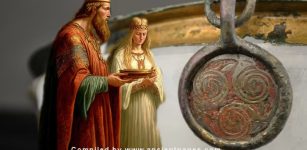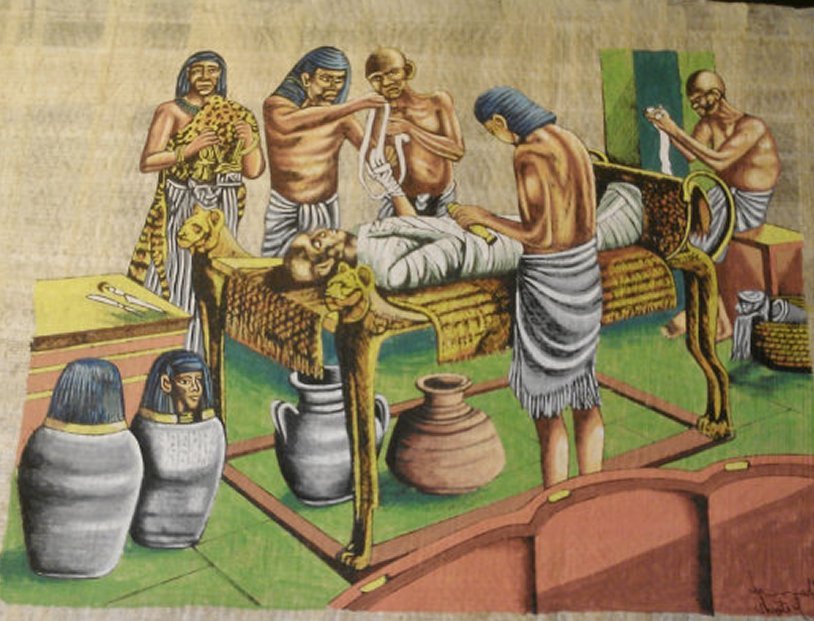Unique Chinchorro Burial Tradition For All And Ancient Egyptians Who Mummified Kings And Nobles Only
A. Sutherland - AncientPages.com - Mummies have long fascinated the world. Mummification is the great ancient tradition and has been a worldwide practice for over 7,000 years.
How were the first techniques of mummification discovered?
The internal organs were removed through the incision and then cleaned, dried, wrapped and placed in four canopic jars. Image via History In An Hour
Millennia ago, in the Middle East, the head were separated from the rest of the dead body and facial features of the dead were modeled on the skull.
It was not mummification as we know it today from archaeological evidence but it was a desire to preserve the human remains and facial features.
Over the centuries, numerous beliefs and funeral practices in many cultures were combined to preserve the posthumous existence of the dead.
In his book "The Golden Branch," James George Fraser wrote that in many cultures, there was no doubt that the aging of the body and its postmortem decay can harmfully affect the soul that inhabits it. It was therefore necessary to prevent changes that could lead to the death of the soul.
The Chinchorro culture that lived on the coast of present day northern Chile and southern Peru, created the earliest known mummies.
A Chinchorro mummy - at San Miguel de Azapa Museum in Arica, Chile; Arica is often referred to as the driest place on Earth, but locals say that is changing. Photograph: Vivien Standen/Washington Post
They preserved all their dead using elaborate techniques. The dead remained with the living and symbolized as the link between the dead and the living.
Recent research indicates that the tradition of embalming in Egypt is much older than previously thought and can match the age of Chinchorro culture.
The Egyptians constantly refined their mummification process, and by the New Kingdom period, they had perfected their techniques, so even today Roman Catholic Church follows them when preserving the bodies of deceased popes.
See also:
Mystery Of The Chinchorro Civilization And The World’s Oldest Mummies
Canopic Jars: Funerary Tradition Of Ancient Egyptians And Their Beliefs In Afterlife
Viking Burial Rituals: High Ancient Funeral Pyre Reflected High Social Status
To the ancient Egyptians, death was the next step in a great process of continuation of life – afterlife. But to participate in it, the body had to be properly preserved.
The Egyptians were wrapping their dead in linen as early as c.3400 BC, with linen impregnated with resin or sometimes with plaster to preserve the contours of the body. Around 2600 BC, they began to remove the internal organs (except for the kidneys) to prevent decomposition. The brain, which was never preserved, was removed through the nose with an instrument that looked like a hooked metal rod.
For the next three millennia, the Egyptians refined and perfected their techniques and by New Kingdom times, about 1570-1070 BC, they became the world’s most skilled and famous practitioners of mummification.
It was long believed that the Chinchorro people of Chile preserved bodies before the Egyptians. First, now researchers have been able to analyze ancient Egyptian graves at Mostagedda, Badari and Hierakonpolis and the results indicate that buried bodies were subjected to embalming treatments before being deposited in the grave.
Dating of these burials to the fifth millennium BC makes them the contemporaries of the Chinchorro mummy of South America.
However, the Chinchorro burial practices were unique in many ways.
Bernardo Arriaza, an expert on the mummies, which were first discovered in the Atacama desert in 1917, wrote that “…whereas the Egyptians considered only kings and other exalted citizens worthy of mummification, the Chinchorro accorded everyone in the community, regardless of age or status, this sacred rite…”.
Without pottery farming and literacy, the Chinchorro people were considered as primitive, but interestingly, they possessed complex mummification techniques that confirm they were a highly sophisticated culture.
From c.6000 BC, the Chinchorro began to 'rebuild' their dead, with bodies carefully removed flesh and the skin, brain and internal organs removed. The bones were dried with hot ashes before the whole lot was then reassembled using twigs for reinforcement bound tightly with reeds.
Finally, a layer of ash paste was applied over the body, a clay mask used to cover the face and a wig made of human hair was placed on the head.
At first, only infants and children, decorated with vibrant colors and diverse clay figurines. At its peak around 3000 BC, Chinchorro mummified men, women, and children of all ages and in the final days of this culture, the mummies bore only mud masks. The mummies were apparently not buried but were stood upright in a visible location in the camp, perhaps to indicate the group’s lineage from a common ancestor.
In addition, not all members of Chinchorro bands were mummified; some were buried in simple graves. Such graves have been found on elevated terraces and containing one or more individuals who may have been family groups.
Written by – A. Sutherland AncientPages.com Staff Writer
Copyright © AncientPages.com All rights reserved. This material may not be published, broadcast, rewritten or redistributed in whole or part without the express written permission of AncientPages.com
Expand for referencesReferences:
Andrews C. Egyptian Mummies: Revised Edition
Stein R. L. Stein P. Anthropology of Religion, Magic, and Witchcraft
Sciencing - In Ancient Egypt, What Did They Put in a Mummy's Stomach?
More From Ancient Pages
-
 Ancient City Of Gordium, Gordian Knot And Skeleton In Tumulus Of King Midas
Civilizations | Sep 20, 2018
Ancient City Of Gordium, Gordian Knot And Skeleton In Tumulus Of King Midas
Civilizations | Sep 20, 2018 -
 Tomb Of Celtic Prince Has Been Unearthed In France
Archaeology | Mar 5, 2015
Tomb Of Celtic Prince Has Been Unearthed In France
Archaeology | Mar 5, 2015 -
 Undiscovered Neanderthal Artifacts From The Ice Age Are Submerged Below The Waves Of The English Channel
Archaeology | Nov 23, 2022
Undiscovered Neanderthal Artifacts From The Ice Age Are Submerged Below The Waves Of The English Channel
Archaeology | Nov 23, 2022 -
 Amazing Discovery Of A Wakizashi, Japanese Sword In Berlin-Mitte
Archaeology | Aug 28, 2024
Amazing Discovery Of A Wakizashi, Japanese Sword In Berlin-Mitte
Archaeology | Aug 28, 2024 -
 Probably The Oldest Star Map Discovered In Stone Chamber Of The Kitora Tomb, Asuka Nara, Japan
Ancient History Facts | Jul 19, 2015
Probably The Oldest Star Map Discovered In Stone Chamber Of The Kitora Tomb, Asuka Nara, Japan
Ancient History Facts | Jul 19, 2015 -
 Unusual Biblical Cloud – What Was This Perplexing Atmospheric Phenomenon?
Ancient Mysteries | Feb 22, 2019
Unusual Biblical Cloud – What Was This Perplexing Atmospheric Phenomenon?
Ancient Mysteries | Feb 22, 2019 -
 Controversial Prehistoric Bronze Gears Of Peru
Artifacts | Aug 15, 2015
Controversial Prehistoric Bronze Gears Of Peru
Artifacts | Aug 15, 2015 -
 Why Is The Yarm Viking Helmet Special?
Archaeology | Aug 10, 2020
Why Is The Yarm Viking Helmet Special?
Archaeology | Aug 10, 2020 -
 The Egyptian Dream Book Reveals Ancient Predictions Of The Future
Egyptian Mythology | Jun 6, 2020
The Egyptian Dream Book Reveals Ancient Predictions Of The Future
Egyptian Mythology | Jun 6, 2020 -
 11 Ancient Submerged Canoes Found In Wisconsin’s Lake Mendota – Evidence Of A Lost Village?
Archaeology | May 27, 2024
11 Ancient Submerged Canoes Found In Wisconsin’s Lake Mendota – Evidence Of A Lost Village?
Archaeology | May 27, 2024 -
 Rare 1,600-Year-Old Wooden Pagan Idol Discovered In Ireland
Archaeology | Aug 16, 2021
Rare 1,600-Year-Old Wooden Pagan Idol Discovered In Ireland
Archaeology | Aug 16, 2021 -
 Mystery Of The Anglo-Saxon Burial At Lowbury Hill May Soon Be Solved
Archaeology | Mar 7, 2023
Mystery Of The Anglo-Saxon Burial At Lowbury Hill May Soon Be Solved
Archaeology | Mar 7, 2023 -
 Who Were The Goths And Where Did They Come From?
Civilizations | Apr 16, 2019
Who Were The Goths And Where Did They Come From?
Civilizations | Apr 16, 2019 -
 Scotland’s Oldest Tartan On Display For The First Time!
Artifacts | Apr 6, 2023
Scotland’s Oldest Tartan On Display For The First Time!
Artifacts | Apr 6, 2023 -
 Legendary ‘Orichalcum Metal’ Related To Atlantis Found In 2,600-Year-Old Shipwreck
Archaeology | Mar 3, 2017
Legendary ‘Orichalcum Metal’ Related To Atlantis Found In 2,600-Year-Old Shipwreck
Archaeology | Mar 3, 2017 -
 On This Day In History: Antarctic Explorer Lawrence “Titus” Oates Born – On Mar 17, 1880
News | Mar 17, 2017
On This Day In History: Antarctic Explorer Lawrence “Titus” Oates Born – On Mar 17, 1880
News | Mar 17, 2017 -
 Researchers Find Oldest Evidence Of Human-Caused Lead Contamination In Aegean Region
Archaeology | Feb 4, 2025
Researchers Find Oldest Evidence Of Human-Caused Lead Contamination In Aegean Region
Archaeology | Feb 4, 2025 -
 Toruń Massive ‘Roundels’ Date Back 7,000 Years – Archaeologists Say
Archaeology | Jul 6, 2020
Toruń Massive ‘Roundels’ Date Back 7,000 Years – Archaeologists Say
Archaeology | Jul 6, 2020 -
 The Parthenon Marbles Evoke Particularly Fierce Repatriation Debates – An Archaeologist Explains Why
Artifacts | Jul 1, 2024
The Parthenon Marbles Evoke Particularly Fierce Repatriation Debates – An Archaeologist Explains Why
Artifacts | Jul 1, 2024 -
 Svantevit – Four-Headed War God Of The Slavic Peoples Of Central Europe
Featured Stories | Sep 13, 2015
Svantevit – Four-Headed War God Of The Slavic Peoples Of Central Europe
Featured Stories | Sep 13, 2015




